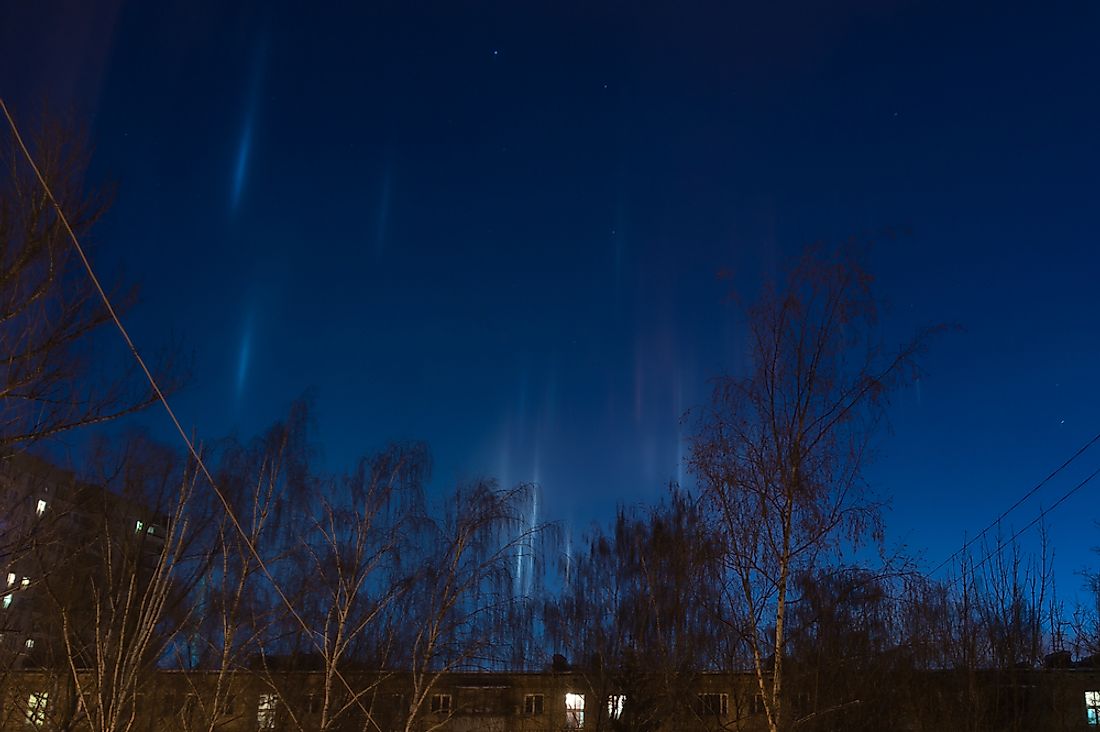What Is A Light Pillar?

Fascinating phenomena are visible as a result of the Earth’s atmosphere’s optical properties. Most optical phenomenon result from the interaction between light and matter in the atmosphere. A light pillar is one such optical phenomenon which results from the interaction of ice crystals in the atmosphere with light, which could either be natural or artificial. The mode of creation of the pillars is reflection of the light by the ice crystals. These numerous ice crystals are believed to be suspended in a near horizontal manner in the sky and clouds. As ice crystals fall through the ether, they do so by a side-to side rocking mechanism thus presenting horizontal faces that reflect away any light shone upon them. Streetlights have been known to produce light pillars, which can be seen at night any time. When the source of the light is the sun or the moon, the light pillars are referred to as solar pillars or lunar pillars respectively.
Solar Pillars
The sun is the light source with the ice crystals being the matter that reflects the light. Sun pillars extend vertically from the sun, either downwards or upwards. These pillars are a beautiful fascinating phenomenon that has attracted documentation in history books. An example is the solar pillar observed after a storm had passed by Dawn Tabb and Joe C. Tabb in 2016 which they described as “amazing”. In the same year on the first evening of the spring, along the U.S West Coast, a solar pillar was observed. Solar pillars are majorly associated with cirrostratus clouds which are high-level and thin. These are often visible in the atmosphere after the break of dawn or before sunset when the sun is low.
Formation Of Light Pillars
Ice crystals and a light source are essential for formation of light pillars. In solar pillar formation, the orientation and appearance of the surfaces is vital. The horizontal orientation of ice crystals that are hexagonal in shape and flat is ideal for an optical vertical pillar column formation.Acting in a collective format, light beam form the sun is reflected by the ice crystals in the same manner that light would be reflected by a big mirror. This leads to formation of a virtual image. The horizontal orientation is deviated by turbulence leading to the virtual image, which is the reflection to be elongated into a visible column in the Earth’s atmosphere. The size of ice crystals is directly proportional to the pillar effect produced. Thus, the most visible solar pillars are observed in winter when the ice crystals in the atmosphere are larger in size. There are instances when these pillars are formed too close to the ground producing what is known as a diamond dust, a common phenomenon in very cold weather attributed to ice crystals being suspended lowly.
For light pillars, especially those resulting from artificial light, it is more of an optical illusion than an actual column of a reflected light beam. Part of the collective reflection that appears in a vertical manner sends light rays to the observer which often creates the illusion of a pillar.











